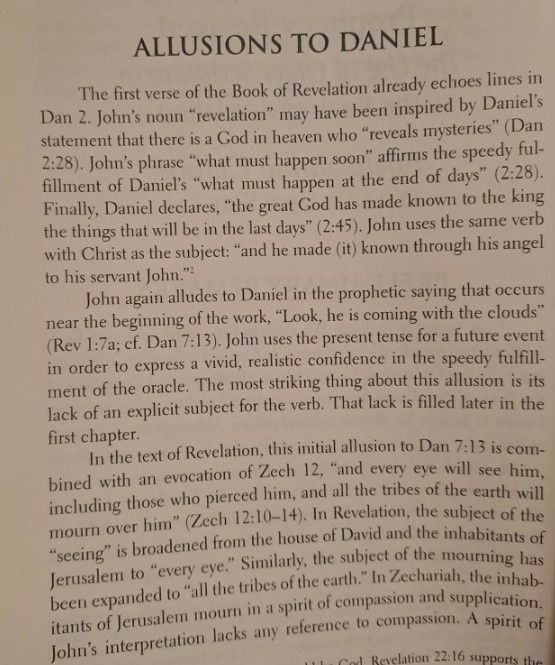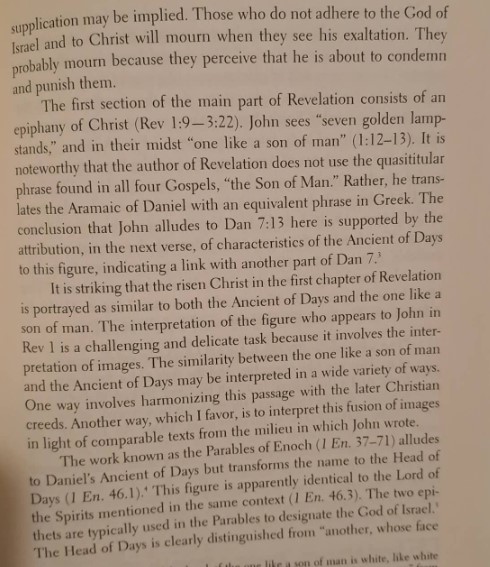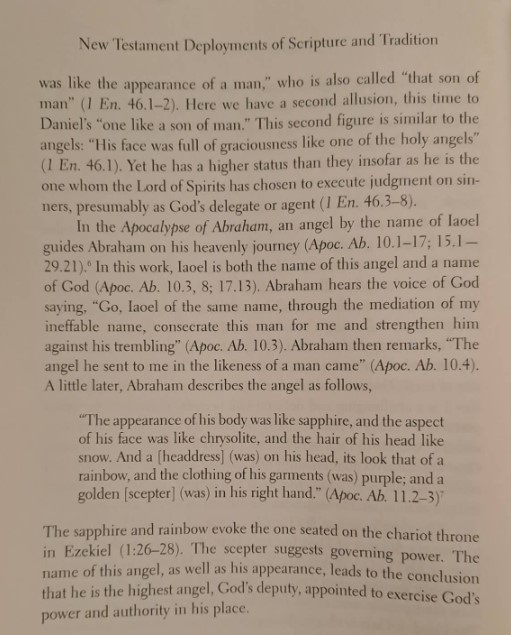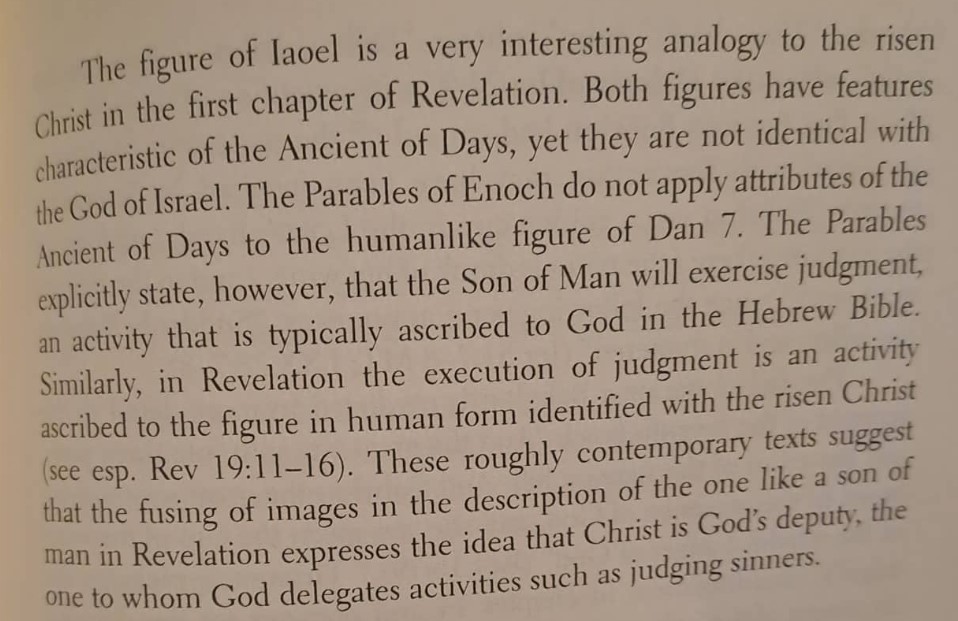Adela Yarbro Collins discusses the depiction of Jesus in Revelation 1; notes that, as with Iaoel in Jewish literature, Jesus parallels, but is not the same person as, the Ancient of Days.
- Type
- Book
- Source
- Adela Yarbro Collins Non-LDS
- Hearsay
- DirectSecondary
- Reference
Adela Yarbro Collins, “Prophecy Revived: The Use of Older Scripture in the Book of Revelation,” in Biblical Essays in Honor of Daniel J. Harrington, SJ, and Richard J. Clifford, SJ: Opportunity For No Little Instruction, ed. Christopher G. Frechette, Christopher R. Matthews, and Thomas D. Stegman (New York: Paulist Press, 2014), 256-59
- Scribe/Publisher
- Paulist Press
- People
- Adela Yarbro Collins
- Audience
- Reading Public
- Transcription
ALLUSIONS TO DANIEL
The first verse of the Book of Revelation already echoes lines in Dan 2. John’s noun “revelation” may have been inspired by Daniel’s statement that there is a God in heaven who “reveals mysteries” (Dan 2:28). John’s phrase “what must happen soon” affirms the speedy fulfillment of Daniels’ “what must happen at the end of days” (2:28). Finally, Daniel declares, “the great God has made known to the king the things that will be in the last days” (2:45). John uses the same verb with Christ as the subject: “and he made (it) known through his angel to his servant John.”
John again alludes to Daniel in the prophetic saying that occurs near the beginning of the work, “Look, he is coming with the clouds” (Rev 1:7a; cf. Dan 7:13). John uses the present tense for a future event in order to express a vivid, realistic confidence in the speedy fulfillment of the oracle. The most striking thing about this allusion is its lack of an explicit subject for the verb. That lack is filled later in the first chapter.
In the text of Revelation, this initial allusion to Dan 7;13 is combined with an evocation of Zech 12, “and every eye will see him, including those who pierced him, and all the tribes of the earth will mourn over him” (Zech 12:10-14). In Revelation, the subject of the “seeing is broadened with the house of David, and the inhabitants of Jerusalem mourn in a spirit of compassion and supplication. John’s interpretation lacks any reference to compassion. A spirit of supplication may be implied. Those who do not adhere to the God of Israel and to Christ will mourn when they see his exaltation. They probably mourn because they perceive that he is about to condemn and punish them.
The first section of the main part of Revelation consists of an epiphany of Christ (Rev 1:9-3:22). John sees “seven golden lampstands,” and in their midst “one like a son of man” (1;12-13). It is noteworthy that the author of Revelation does not use the quasititular phrase found in all four Gospels, “the Son of Man.” Rather he translates the Aramaic of Daniel with an equivalent phrase in Greek. The conclusion that John alludes to Dan 7:13 here is supported by the attribution, in the next verse, of characteristics of the Ancient of Days to this figure, indicating a link with another part of Dan 7.
It is striking that the risen Christ in the first chapter of Revelation is portrayed as similar to both the Ancient of Days and the one like a son of man. The interpretation of the figure who appears to John in Rev 1 is a challenging and delicate task because it involves the interpretation of images. The similarity between the one like a son of man and the Ancient of Days may be interpreted in a wide variety of ways. One way involves harmonizing this passage with the later Christian creeds. Another way, which I favor, is to interpret this fusion of images in light of comparable texts from the milieu in which John wrote.
The work known as the Parables of Enoch (1 En. 37-71) alludes to Daniel’s Ancient of Days but transforms the name to the Head of Days (1 En. 46.1). This figure is apparently identical to the Lord of the Spirits mentioned in the same context (1 En. 46:3). The two epithets are typically used in the Parables to designate the God of Israel. The Head of Days is clearly distinguished from “another, whose face was like the appearance of a man,” who is also called “that son of man” (1 En. 46.1-2). Here we have a second allusion, this time to Daniel’s “one like a son of man.” This second figure is similar to the angels: “His face was full of graciousness like one of the holy angels” (1 En. 46.1). yet he has a higher status than they insofar as he is the one whom the Lord of Spirits has chosen to execute judgment on sinners, presumably as God’s delegate or agent (1 En. 46.3-8).
In the Apocalypse of Abraham, an angel by the name of Iaoel guides Abraham to his heavenly journey (Apoc. Ab. 10.1-7; 15.1-29.21). In this work, Iaoel is both the name of this angel and a name of God (Apoc. Ab. 10.3, 8; 17.13). Abraham hears the voice of God saying, “Go, Iaoel of the same name, through the mediation of my ineffable name, consecrate this man for me and strengthen him against his trembling” (Apoc. Ab. 10.3). Abraham then remarks, “The angel he sent to me in the likeness of man came” (Apoc. Ab. 10.4). A little later, Abraham describes the angel as follows,
“The appearance of his body was like sapphire, and the aspect of his face was like chrysolite, and the hair of his head like snow. And a [headdress] (was) on his head, its look that of a rainbow, and the clothing of his garments (was) purple; and a golden [scepter] (was) in his right hand.” (Apoc. Ab. 11.2-3)
The sapphire and rainbow evoke the one seated on thee chariot throne in Ezekiel (1:26-28). The scepter suggests governing power. The name of this angel, as well as his appearance, leads to the conclusion that he is the highest angel, God’s deputy, appointed to exercise God’s power and authority in his place.
The figure of Iaoel is a very interesting analogy to the risen Christ in the first chapter of Revelation. Both figures have features characteristic of the Ancient of Days, yet they are not identical with the God of Israel. The Parables of Enoch do not apply attributes of the Ancient of Days to the humanlike figure of Dan 7. The Parables explicitly state, however, that the Son of Man will exercise judgment, an activity that is typically ascribed to God in the Hebrew Bible. Similarly, in Revelation the execution of judgment is an activity ascribed to the figure in human form identified with the risen Christ (see esp. Rev 19:11-16). These roughly contemporary texts suggest that the fusing of images in the description of the one like a son of man in Revelation expresses the idea that Christ is God’s deputy, the one to whom God delegates activities such as judging sinners.
- Citations in Mormonr Qnas
The B. H. Roberts Foundation is not owned by, operated by, or affiliated with the Church of Jesus Christ of Latter-day Saints.




